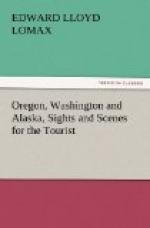Killisnoo used to be a point where 100,000 barrels of herring oil were put up annually. The industry is now increasing again.
Natural wealth.
And this reminds me that I am almost neglecting a reference to Alaska’s vast resources in forests, metals, furs, and fish. There are 300,000,000 of acres densely wooded with spruce, red and yellow cedar, Oregon pine, hemlock, fir, and other useful varieties of timber. Canoes are made from single trees, sixty feet long, with eight-feet beams.
Gold, silver, lead, iron, coal, and copper are encountered in various localities. Though but little prospected or developed, Alaska is now yielding gold at the rate of about $2,000,000 per year. There is a respectable area of island and mainland country well adapted to stock-raising, and the production of many cereals and vegetables. The climate of much of the coast country is milder than that of Colorado, and stock can feed on the pastures the year round.
But, if Alaska had no mines, forests, or agriculture, its seal and salmon fisheries would remain alone an immense commercial property. The salmon are found in almost any part of these northern waters where fresh water comes in, as they always seek those streams in the spawning season. There are different varieties that come at stated periods and are caught in fabulous numbers, sometimes running solid ten feet deep, and often retarding steamers when a school of them is overtaken. At Idaho Inlet Mr. Van Gasken brought up a seine for the Ancon tourists containing 350 salmon for packing. At nearly every port the steamer landed there was either one or more canning or salt-packing establishments for salmon. Of these, 11,500,000 pounds were marketed last year.
Besides the salmon there is the halibut, black and white cod, rock cod, herring, sturgeon, and many other fish, while the waters are whipped by porpoises and whales in large numbers all along the way. Governor Swineford estimates the products of the Alaska fisheries last year at $3,000,000.
THE SEAL FISHERIES
are still 1,800 miles west of Sitka. St. Paul and St. George Islands are the best breeding places of the seals, sea lions, sea otter, and walrus. These islands are in a continuous fog in summer, and are swept by icy blasts in winter. There are many interesting facts connected with these islands and the habits of these phocine kindred, but space is limited. Suffice that 100,000 seals are killed each year for commercial purposes. Over 1,000,000 seal pups are born every year, and when they leave for winter quarters they go in families and not altogether. An average seal is about six feet long, but some are found eight feet long and weigh from 400 to 800 pounds. The work of catching is all done between the middle of June and the first of August. The fur company are supposed to pay our Government $2 for each pelt. These hides are at once shipped to London to be dyed and made ready to be put on the market in the United States.




